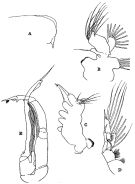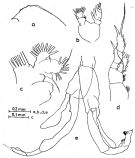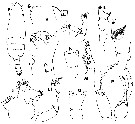|
|
 |
|
Calanoida ( Order ) |
|
|
|
Clausocalanoidea ( Superfamily ) |
|
|
|
Aetideidae ( Family ) |
|
|
|
Chirundina ( Genus ) |
|
|
| |
Chirundina indica Sewell, 1929 (F,M) | |
| | | | | | | Ref.: | | | Sewell, 1929 (p.119, Descr.F, figs.F, juv.M, Rem.); 1947 (p.92, Descr.F,M, figs.M); Grice, 1962 (p.196, figs.F, Rem.); Tanaka, 1969 (p.262, Descr.M, figs.M); Morris, 1970 (p.2300, 2306, figs.M); Silas, 1972 (p.646); Bradford & Jillett, 1980 (p.27); Markhaseva, 1996 (p.130, figs.F) |  issued from : R.B.S. Sewell in The John Murray Expedition, 1933-34, Scientific Reports, VIII (1), 1947. [p.93, Fig.20]. Male (from G. of Aden): A, forehead (lateral); B, Mx1; C, Mx2; D, P1; E, P5. Nota: - The proportional lengths of the various segments of the body (cephalon to caudal rami) . - Forehead crowned by a small, and somewhat inconspicuous crest. - Right A1 20-segmented (segments 8-9-10, 12-13, 24-25 respectively fused, left 21-segmented (segments 20 and 21 separate). - Md without biting blade, but the palp well developed. - Mx1 with the 1st inner lobe represented by a rounded process, 2nd inner lobe very small, devoid of any setae, 3rd inner lobe moderately well formed with a single seta; the 2nd basal segment and the endopod together bear 10 or 11 small setae; the exopod carries 10 well-formed, long flexible setae; the outer lobe bears 5 long setae. - Mx2 much reduced, 5 lobes, of which the proximal three are devoid of any setae and the 4th and 5th with 1 each.; the terminal portion bears 6 very small setae. Nota Female: - Proportional lengths of cephalothorax and abdomen as 79 to 21. The proportional lengths of the various segments of the body (cephalon to caudal rami) as 519 (374:145) : 94 : 8 1: 67 : 101 : 47 : 3 4: 20 : 37 =1000. - The fusion of the cephalon and 1st pediger thoracic segment is not quite complete, the line of fusion being visible in the mid-dorsal line. - A1 23-segmented (segments 8-9 and 24-25 respectively fused. - The mouth parts appear to be identical with those of C. streetsi. - Proximal segment of the exopod of P1 partly fused with the 2 nd segment, devoid of any marginal spine.
|
 issued from : O. Tanaka in Publ. Seto Mar. Lab., 1969, XVII (4). [Fig.5]. Male (from off Philippines): a, forehead (lateral); b, Md (mandibular palp); c, Mx1; d, P1; e, P5. Nota Male: - A1 extends to the distal margin of the caudal rami. - Exopod of A2 about 1.5 times as long as the endopod; endopod with 6 setae on the outer lobe, and 7 setae on the inner lobe. - Md with 9 setae on endopod, 6 setae on exopd. - Mx1: outer lobe with 5 setae; exopod with 11 setae; endopod with 8 setae; 2nd basal segment with 3 setae; 3rd inner lobe with 1 seta; 1st and 2nd inner lobes much reduced.P1 exopod 3-segmented, endopod 1-segmented; no marginal spine on the 1st exopodal segment. For Sewell, the A2 has 8 setae on the inner and outer lobes respectively, in the present specimen an inner marginal seta might have lost. Mx1 has 11 setae on exopod and 11 setae on endopod including the 2nd basal segment in the present specimen, whereas, it has 10 and 10 setae respectively in Sewell's one.
|
 issued from : R.B.S. Sewell in Mem. Indian Mus., 1929, X. [p.121, Fig.46]. Female (from Laccadive Sea): a, habitus (dorsal); b, forehead (lateral); c, urosome (dorsal); d, idem (lateral right side); e, A2; f, Mx1; g, Mx2; h, P1.
|
 issued from : R.B.S. Sewell in Mem. Indian Mus., 1929, X. [p.120, Fig.45]. Female: a, labrum (oral view); b, lamina labialis (oral view).
|
 issued from : G.D. Grice in Fish. Bull. Fish and Wildl. Ser., 1962, 61. [p.197, Pl.11, Figs.5-20]. Female (from 01°10'S, 134°57'W): 5, forehead (lateral); 6, posterior part of thorax and urosome (dorsal); 7, same (ventral); 8, same ( (lateral, right side); 9, A2; 10, Md (mandibular palpus); 11, Md (cutting edge); 12, Mx1; 13, terminal part of 3rd inner lobe of Mx1; 14, Mx2; 15, 1st basipodal segment of Mxp; 16, distal part of Mxp; 17, P1; 18, P2 (one exopod and one endopod missing); 19, P3; 20, P4 (distal part of exopod missing). Nota: Forehead with a low crest. Smoothly rounded posterior thoracic margins and presence of but 1 external spine on the 1st exopodal segment of P1 Except for the posterior thoracic margins, which have 1 small projection, the specimen agrees with Sewell's indicaIn details of the mouth parts, two minor differences were noted: Sewell's specimens have 6 setae on the outer lobe of A2, while the Pacific specimen has 7 setae; exopod of Md with 9 setae (Sewell probably referred to the distal setae, the Pacific specimen has 10 setae, one of which is extremely small. The projections on the posterior thoracic margins may be a variable character as Vervoort (1957) has observed in several species of a related genus, Undeuchaeta.
|
 issued from : B. Morris in J. Fish. Res. Bd Canada, 1970, 27 (12). [p.2307, Fig.4, F-P]. Male (from North subtropical central Pacific): F, habitus (dorsal); G, forehead (lateral); H, posterior prosome andanterior urosomal segments (lateral); I, A2; J, Mx1; K, Mx2; L, Mxp; M, P1 (posterior); N, exopodal segments 1 and 2 of P1; O, exopodal segments 1 and 2 of P1 (variant form); P, P5. Nota: Two of male specimens lacked spine on the exopodal segment 1 of P1 (figs.M, N), the third had a a minute spinule in this position (Fig. O). The general body shape (fig.F), and general details of most of the appendages, agree with Sewell's diagnosis. Slight differences were noted in the A2, (6 rather than 8 setae on the external lobe of the endopodal segment 2, and 2 rather than 1 small protuberance on the exopodal segment 1. The endopod of Mx1 has a smaller setule in addition to the 10 strong setae.
|
 Chirundina indica Chirundina indica female: 1 - Crest on cephalon present. 2 - Exopodal segment 1 of P1 without external spine. Cephalothorax nearly 3.8 times longer than urosome.
|
 Chirundina indica Chirundina indica male: 1 - Exopodal segment 1 of P1 without external spine.
| | | | | Compl. Ref.: | | | Sewell, 1948 (p.329, 530, 531, 534, 539, 541); Mullin, 1966 (p.546, Table I, III, diet); Grice & Hulsemann, 1967 (p.14); Guangshan & Honglin, 1984 (p.118, tab.); Sano & al., 2013 (p.11, Table 7, food habits) | | | | NZ: | 4 | | |
|
Distribution map of Chirundina indica by geographical zones
|
| | | | | | | | | | Loc: | | | G. of Aden, Arabian Sea, Maldive Is., Laccadive Is., off La Réunion Is., off SW Sri Lanka, SW Indian, S Indian Ocean, off Philippines, China Seas (tropical), W Pacif. (equatorial), Pacif. (central N subtropical ), Pacif. (equatorial).
Type locality: 5°56'N, 76°22'E. | | | | N: | 9 | | | | Lg.: | | | (11) F: 5-4,05; M: 3,967; (29) F: 4,75-4,19; (37) F: 5-4,05; M: 4,1-3,75; (92) M: 4,06-3,88; (101) F: 4,66; (105) M: 3,75; {F: 4,05-5,00; M: 3,75-4,10} | | | | Rem.: | epi-mesopelagic.
Morris (1970, p.2306) founded this species together with C. streetsi and after Sewell (1929, 1947) both the male and female of C. indica differ from C. streetsi in lacking an outer marginal spine on the exopodal segment 1 of P1. This spine is very conspicuous in C. streetsi. | | | Last update : 28/03/2017 | |
|
|
 Any use of this site for a publication will be mentioned with the following reference : Any use of this site for a publication will be mentioned with the following reference :
Razouls C., Desreumaux N., Kouwenberg J. and de Bovée F., 2005-2025. - Biodiversity of Marine Planktonic Copepods (morphology, geographical distribution and biological data). Sorbonne University, CNRS. Available at http://copepodes.obs-banyuls.fr/en [Accessed December 03, 2025] © copyright 2005-2025 Sorbonne University, CNRS
|
|
 |
 |









